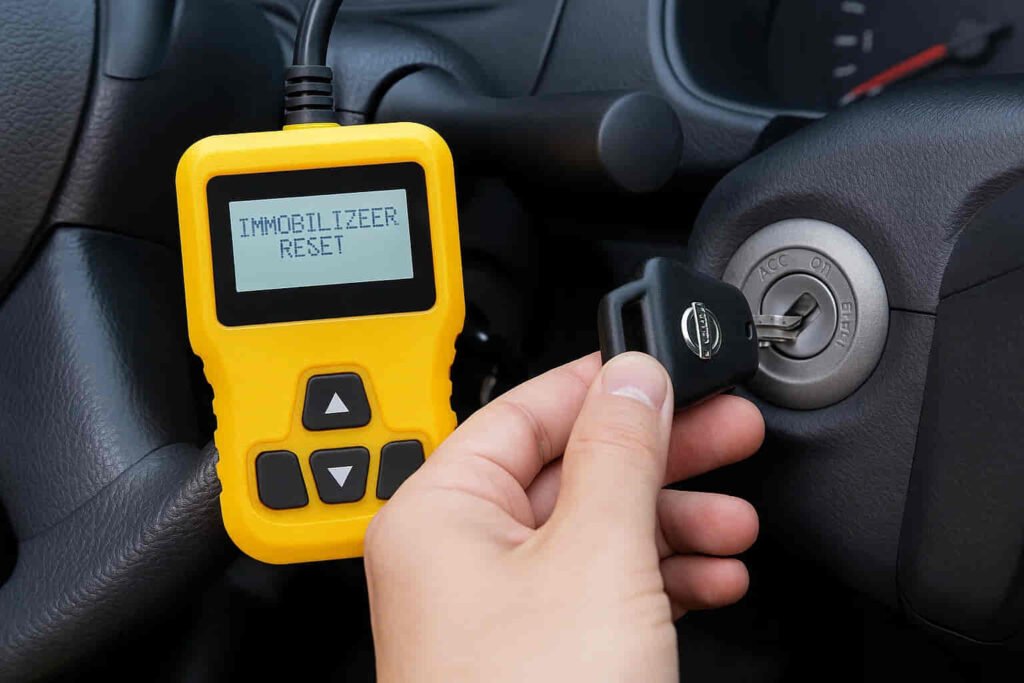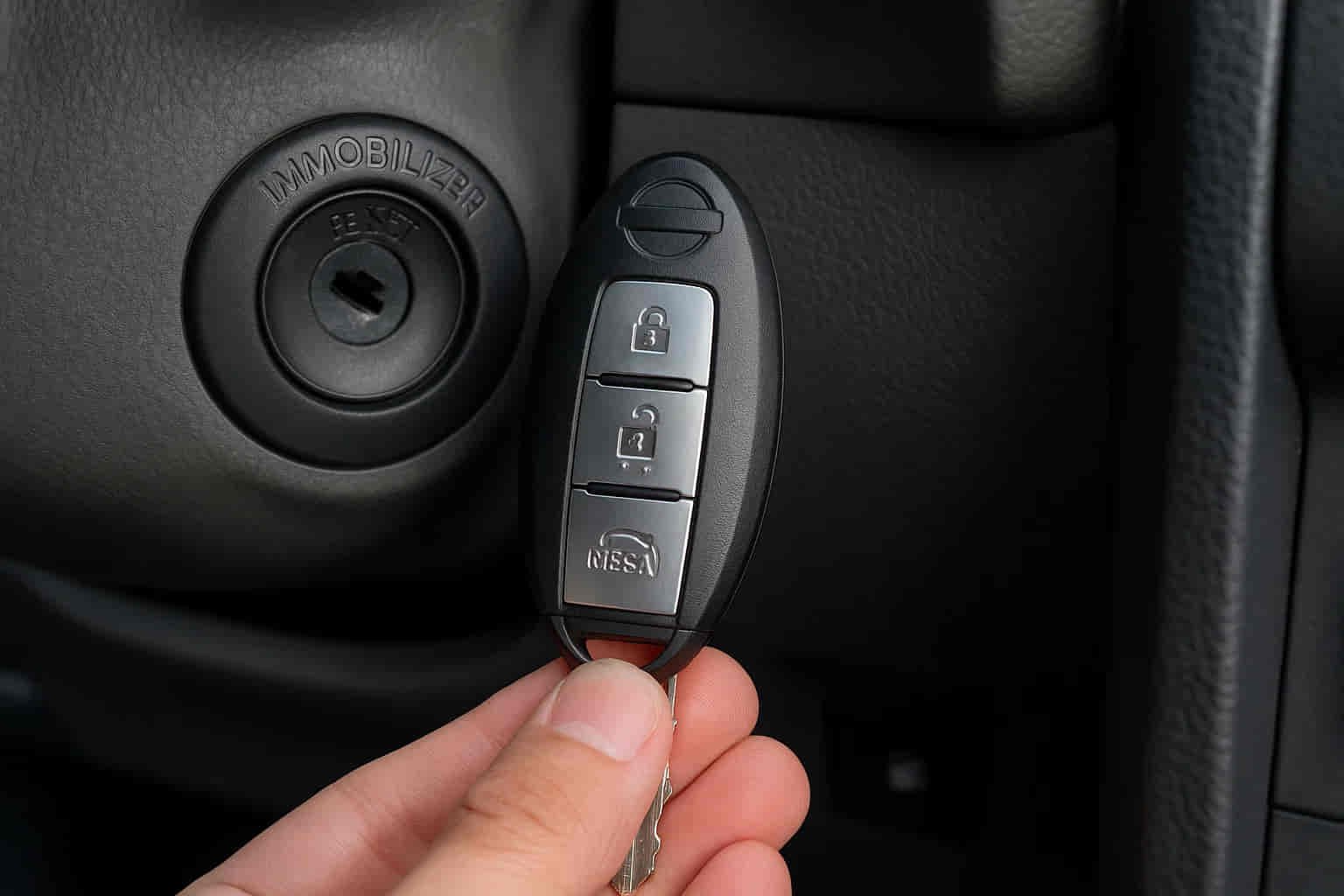There are few things more frustrating than turning the key in your Nissan, seeing the immobilizer light flash, and realizing the engine will not start. For many drivers, this moment feels like being locked out of their own car even though the key is in hand. The immobilizer system is designed as a theft prevention feature, but when it malfunctions or loses synchronization with the key fob, it can turn into an unexpected obstacle. Learning how to perform a Nissan immobilizer reset can save you time, towing fees, and the stress of waiting at the dealership.
This guide walks you through the process of understanding why the immobilizer blocks ignition and how you can reset it safely. Instead of jumping into complicated technical jargon, we will focus on clear steps that apply to common Nissan models such as Altima, Sentra, Rogue, and X-Trail. Along the way, you will also discover the typical reasons an immobilizer fails, the tools that might help, and when it is smarter to stop troubleshooting and call a professional. By the end, you will know not just how to reset your Nissan immobilizer, but also how to prevent the same issue from stranding you again.
Quick checklist before you start
Before attempting any Nissan immobilizer reset, it is important to pause and make sure the problem really comes from the immobilizer system. Many drivers rush straight into programming sequences without confirming the basics, which often leads to wasted time or unnecessary panic. A weak car battery, for instance, can mimic immobilizer failure by cutting power to the ECU and triggering the warning light. Replacing or charging the battery should always be the first step before assuming a reset is needed.
The same applies to the key itself. A depleted key fob battery can prevent the transponder chip from sending the proper signal to the immobilizer unit. Testing with a spare key, if available, is one of the simplest ways to confirm whether the fault lies in the immobilizer or the key fob. Observing the behavior of the immobilizer light on the dashboard is equally valuable. A steady light usually indicates a different electrical issue, while a flashing pattern suggests the key is not recognized.
You should also consider the condition of the car’s wiring and grounding points. Loose terminals or corrosion near the battery can disrupt the signal chain between the ECU and immobilizer. If you have access to an OBD2 scanner, running a quick check for fault codes will often point you in the right direction. Ensuring these preliminary steps are covered will give you a clearer starting point and increase the chances of a successful Nissan immobilizer reset without costly interventions.
Universal Nissan Immobilizer Reset — Step-by-step

When a Nissan refuses to start because the immobilizer does not recognize the key, a simple reset procedure can often bring the system back to life. Although exact steps vary across models, most Nissan vehicles follow a similar sequence that allows the ECU and the key fob to resynchronize. It begins with preparing the vehicle properly. All doors should be closed, the ignition should be set to the “ON” position without starting the engine, and the original key should be used to ensure compatibility.
The typical sequence involves inserting the key, turning it to “ON,” and waiting for the immobilizer light to respond. In many cases, leaving the ignition on for about ten minutes allows the system to clear its error state. The light will either turn off or switch from flashing to solid, which signals that the immobilizer has accepted the key. After this, switching the ignition off and then attempting to start the engine should confirm whether the reset has worked.
If the procedure does not succeed, repeating the cycle two or three times may help, as some models require multiple attempts before full synchronization is achieved. It is also recommended to avoid interrupting the process by removing the key too early or letting the battery voltage drop. This universal reset method does not require special equipment and is often enough to restore normal operation, especially on older Nissan models where immobilizer programming is less complex.
Model-specific notes and variations
While the universal reset method works for many Nissans, different models and production years often include variations that drivers should be aware of. For instance, the Nissan Altima from the mid-2000s typically responds well to the ignition-on waiting procedure, but newer Altima models equipped with push-button start rely on slightly different timing with the brake pedal and start button. In these cases, the immobilizer light may take longer to reset, and skipping steps can prevent the car from recognizing the key.
The Nissan Sentra and Rogue models from the last decade often include more sensitive immobilizer systems. Instead of a single ignition cycle, they may require several rounds of the reset sequence before the ECU fully accepts the key signal. Drivers should not be alarmed if the immobilizer light continues flashing after the first attempt; patience is part of the process.
The X-Trail and Pathfinder models, especially those designed for international markets, sometimes integrate the immobilizer with advanced anti-theft modules. Resetting these systems may require both a programmed master key and, in some cases, access to diagnostic equipment. Without these, the immobilizer might reject the reset entirely.
Because each Nissan generation incorporates small changes in the security protocol, it is always useful to check whether your owner’s manual includes notes on immobilizer behavior. While a general reset method can often help, knowing the model-specific variations improves the chance of success and avoids the frustration of repeating the wrong procedure.
Using OBD2/key programmers safely
For some Nissan models, especially the newer ones with advanced security chips, a manual reset is not always enough. This is where OBD2 diagnostic tools and key programmers can make the process faster and more reliable. These devices connect directly to the vehicle’s onboard computer, allowing you to clear immobilizer errors and reprogram the key fob without relying on repeated ignition cycles. However, using them requires caution.
Not every tool on the market is compatible with Nissan immobilizer systems. Generic OBD2 scanners can read error codes but may not offer the reset function you need. Specialized key programmers are usually required, and they must support your specific Nissan model and year. Attempting to use the wrong tool can result in corrupted data or even a locked ECU that requires dealer intervention.
Another factor to keep in mind is legality and safety. Key programming equipment is intended for legitimate owners and licensed locksmiths. Always ensure you can prove ownership of the car before attempting this method, because some tools will request a PIN code from Nissan’s database to complete the reset.
When done correctly, using OBD2 or key programmers can save significant time and reduce costs compared to dealer services. They provide a more permanent solution for immobilizer faults, particularly when the system fails to respond to universal reset steps. Still, for drivers unfamiliar with diagnostic software, consulting a professional locksmith or technician is often the safest choice.
Common problems and fixes if reset fails
Even after following the universal reset steps or using diagnostic tools, there are times when the immobilizer still refuses to cooperate. In most cases, the issue comes from something outside the reset process itself. One of the most common culprits is a weak or unstable car battery. Since the immobilizer relies on a consistent power supply, even a small drop in voltage can cause the ECU to reject the key signal. Checking battery health and replacing it if necessary is often the simplest fix.
Another frequent cause is a damaged or faulty transponder chip inside the key. If the chip is cracked or has lost calibration, no amount of resetting will restore communication. Testing with a spare key is the fastest way to confirm whether the problem lies with the immobilizer system or the key itself.
Wiring problems can also interrupt the signal path between the immobilizer module and the ECU. Corrosion at the terminals, loose grounding points, or moisture in the connectors are issues that mimic immobilizer failure but actually stem from poor electrical contact.
In rare situations, the immobilizer module itself may have failed. When this happens, replacement or professional reprogramming is usually the only solution. If the reset fails repeatedly despite a healthy battery, functional keys, and proper wiring, the safest next step is to seek help from a Nissan dealer or an experienced automotive locksmith who has access to specialized diagnostic equipment.
When to call a professional and expected costs
While do-it-yourself methods can solve many immobilizer problems, there are moments when calling a professional is the most practical choice. If your Nissan repeatedly refuses to accept the reset sequence, or if you notice the immobilizer light behaving inconsistently despite following the correct steps, the issue may be deeper than a simple synchronization error. Situations involving faulty transponder chips, corrupted ECU data, or failed immobilizer modules are almost impossible to resolve without specialized equipment.
Professional locksmiths and Nissan dealerships have access to factory-approved programming tools and security databases. This allows them to retrieve PIN codes, register new keys, and reinitialize immobilizer systems in ways that consumer-level devices cannot. Although this comes at a cost, it often saves drivers from the frustration of endless trial-and-error attempts.
The price of professional intervention varies. A certified locksmith might charge between $100 and $250 for an immobilizer reset or key programming, depending on your location and the model of the car. Dealerships tend to be more expensive, with costs often ranging from $200 to $500, particularly if new keys must be ordered or the immobilizer module requires replacement. While these numbers may feel high, they are still significantly less than replacing the entire ECU.
Knowing when to stop DIY attempts and turn to a professional can prevent further damage and ensure your Nissan is back on the road quickly. In many cases, that decision ultimately saves both money and time.
FAQ
Can I reset a Nissan immobilizer without special tools?
Yes, many older Nissan models accept a manual reset using the ignition-on sequence. However, newer models may require diagnostic equipment.
What does it mean if the immobilizer light keeps flashing?
A flashing light usually indicates that the key is not recognized. This could be due to a weak fob battery, an unprogrammed key, or a communication error.
Will resetting the immobilizer erase my existing keys?
No, a basic reset does not delete registered keys. Only advanced programming at a dealer or locksmith changes the key database.
How long should I wait with the ignition on during a reset?
Typically, around 10 minutes. Some models may require repeating the process several times.
Can I use any OBD2 scanner to reset the immobilizer?
No. Most generic OBD2 scanners only read error codes. You need a compatible key programmer to perform an actual reset.
Is it possible to start a Nissan without a working immobilizer?
Not legally or safely. The immobilizer is designed to prevent theft. Bypassing it without authorization is not recommended.
How do I know if the problem is with the key or the immobilizer?
Testing with a spare key is the quickest way. If the spare works, the original key’s transponder chip is likely damaged.
Why does my Nissan need multiple reset attempts?
Some models are programmed to require repeated cycles before full synchronization occurs. This is normal behavior.
When should I stop trying and call a professional?
If the reset fails after several attempts with a healthy battery and valid key, it’s best to contact a locksmith or dealer.
Conclusion
A malfunctioning immobilizer can turn a simple drive into an unexpected problem, but knowing how to reset it gives Nissan owners an advantage. By checking the basics like the car battery, key fob condition, and wiring before attempting the reset, you eliminate the most common obstacles. Following the universal ignition-on method works for many models, while more complex systems may require multiple attempts, OBD2 tools, or even professional assistance.
The important thing to remember is that the immobilizer is not just an inconvenience; it is a crucial security feature. Handling it carefully ensures your vehicle stays protected while also restoring its ability to start. For older models, a DIY Nissan immobilizer reset can often be enough to get you back on the road, but for newer vehicles, knowing when to stop troubleshooting and seek expert help is essential.
If you have ever faced the immobilizer light flashing at the worst possible time, you understand the frustration it causes. This guide has given you both practical steps and realistic expectations about what works and what does not. Now it is your turn: have you tried resetting your Nissan immobilizer before, and which method worked for you? Share your experience so other drivers can benefit.

